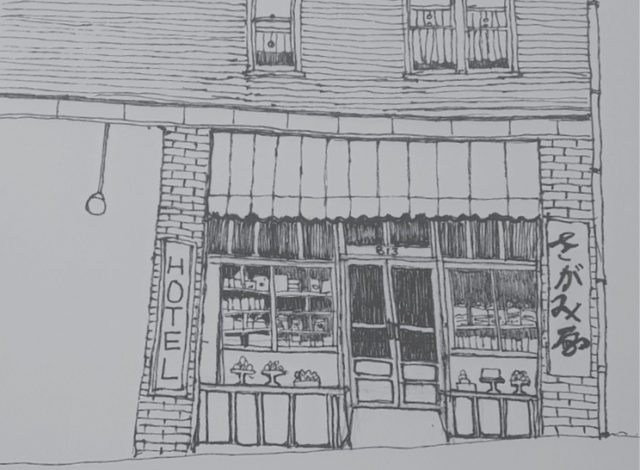By David Yamaguchi, The North American Post
IN LATE WINTER, I was walking downhill on South Jackson St., between Maynard and Sixth Avenues South, when I was suddenly drawn into the Nihonmachi Alley on my right by four large posters hanging there.
The detailed pen-and-ink drawings that comprise the core of each poster are immediately recognizable as the work of Nisei artist, Amy Nikaitani. She alone took the time to capture scenes that today live on mainly in the minds of those of us who remember the tired shopfronts of the International District of the past. As described in Atlantic Monthly (Alana Semuels, Feb. 4), such aged “Chinatown” scenes are disappearing nationally, as previously undervalued inner-city properties are redeveloped for gentrification.
The posters—made by the Wing Luke Museum—are superb in that they bring out Ms. Nikaitani’s fine line-work in a way that reproductions on postcards and handbags in the museum’s gift shop cannot. When I talked with her last summer (see “Artists,” Oct. 2018 online), she had mentioned her work hanging in the alley. However, as I hadn’t seen them at the time, I didn’t grasp how large or nice the reproductions are.

I share two of the four drawings here. As space here is limited, I have taken the liberty to crop each poster to its artwork. I refer interested readers to the alley originals for further details.
The two scenes are ones I recall from my youth. For me, the Sagamiya storefront, on S. Main between Fifth and Sixth Avenues, forever remains the place where Dad proudly displayed the giant matsutake I found as a boy. I remember Asaba-san, the kindly Issei proprietor there, giving me a box of See’s Chocolates as a prize for being a community mushroom contest-winner. His thinking was that I would not value a gallon of Kikkoman soy sauce—a more traditional prize—as we sold such shoyu in our family store, a few blocks away.
The Kokusai Theater, on Maynard east of Jackson, is where we saw most Japanese movies growing up. Typically two films were shown, one “chanbara” historical drama and one “modern” story. I remember my parents not paying so much attention to arriving before the starting time of a movie. We just went when we could get there, and watched both films until we saw the part where we came in.
The other two poster scenes pre-date me. I leave them for readers to view in person.
With this description of the alley posters, what remains to be printed here of Ms. Nikaitani’s work are her more recent nude sketches. I wonder if a series of articles on them here would help make these pages more alluring to youth. Would they help us move a few more newspapers off newsstands, in the name of art?
P.S. As reported in the June 28th issue, Amy Nikaitani passed away in May at the age of 95. Her public art lives on in the Nihonmachi Alley and in the Hirabayashi Place apartments building.







